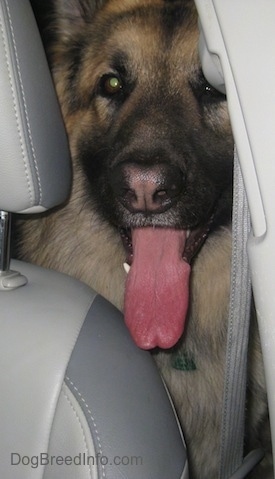
The color of a dog's nose will vary from dog to dog depending on the breed. It can be black, brown, liver, pink, or the same color as its coat. Sometimes a dog's nose can start off one color and change to another as it ages. Puppies are often born with pink noses, which later darken. What does it mean when a dog's nose loses its pigment turning pink or white? The reasons vary. De-pigmentation of the nose is sometimes harmless, but sometimes it is an indication that the dog needs medical attention. Contact your vet if you do not know why your dog's nose has lost its pigment.
Reasons why your dog’s nose may de-pigment:
- The weather: The most common reason a dog's nose loses its pigment is called winter nose or snow nose. Some dog's noses change colors from a dark color to pink in cold weather; turning dark once again when the weather gets warmer. Usually when the nose changes color due to the weather it only partially changes pink as seen in the picture above. Snow nose seems to be directly related to the temperature and is harmless to the dog. The culprit is thought to be a breakdown in an enzyme called tyrosinase, which is what makes melanin. (Melanin is what gives color, or pigment, to the hair, skin and parts of the eyes.) The enzyme is temperature sensitive and gets weaker with age.
Some breeds which are most prone to the nose changing with the weather are the Bernese Mountain Dog, Golden Retriever, Labrador Retriever, Husky and Shepherd.
- Old age: A dog's nose may lose its pigment as it ages.
- Injury: If a dog experiences some kind of trauma such as a scrape or abrasion, the nose can turn pink as it heals. The pigment will usually return after a while.
- Bacterial infection: The nose may not only lighten in color but may look inflamed, sore, crusty or otherwise unhealthy. You may want to contact a veterinarian if this is the case.
- Nasal de-pigmentation, also called “Dudley Nose” is when a dog's nose turns completely pink or even white for unknown reasons. Sometimes the dog's nose never does change back. In some dogs it will randomly regain its pigment or change seasonally.
Breeds most prone to Dudley Nose are the Afghan Hound, Doberman Pinscher, Golden Retriever, Irish Setter, Pointer, Poodle, Samoyed and the White German Shepherd.
- Contact allergies (contact dermatitis): When a dog is allergic to things its nose comes into direct contact with. The lips are usually also affected.You may have to do some investigative work to figure out what the dog is allergic to. The nose and sometimes the surrounding area may look inflamed, sore, crusty or otherwise unhealthy. Sometimes a dog can be allergic to certain types of plastic. You can rule out an allergy to a plastic food bowl by switching to a stainless steel bowl.

- Pemphigus, an immune related skin disorder: This condition can cause sores and crusty areas on and around the dog's nose. The condition is treatable and a vet should be seen.
- Discoid Lupus: Another immune related skin disorder that will also cause sores around and on the dog's nose. The condition can get worse when the dog is exposed to the sun.
- Vitiligo: An immune disease that effects the skin as it blocks healthy, pigment-carrying cells by attacking them with antibodies. This condition can not only turn a dog's nose pink, but you will usually see loss of pigment on other areas of the body, turning the coat white either in scattered hairs or patches. The disorder can get worse over time turning a once dark dog white. A dog with Vitiligo is usually otherwise healthy as it often only effects the dog's appearance.
Breeds most prone to Vitiligo are the Dachshund, Doberman Pinscher, German Shepherd, Labrador Retriever and the Rottweiler.
- Idiopathic is a condition that can make a dog's nose, lips and eyelids lose pigment. The cause is unknown.
- Skin cancer
- VKH-like syndrome or Uveodermatological syndrome (UDS) is an autoimmune disease where one's own defense against infection, the T-cells, attack the melanin-forming cells (melanocytes) in the body. Melanin is what gives color, or pigment, to the hair, skin and parts of the eyes.
Dogs with pink or white noses are prone to sunburn and precautions should be taken. You may need to apply sunscreen before letting the dog outside. In most cases a dog whom's nose has changed colors is not a cause for concern, however, sometimes it is. Be sure to contact your vet to make sure it is not due to a health related issue.
Written by Sharon Rose© Dog Breed Info Center® All Rights Reserved